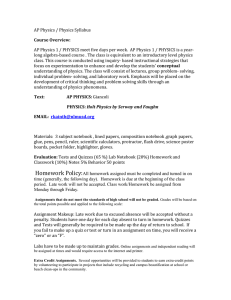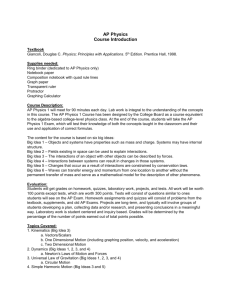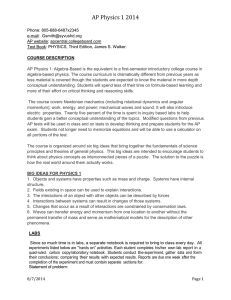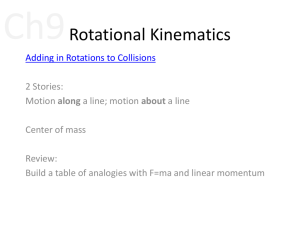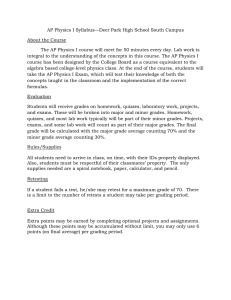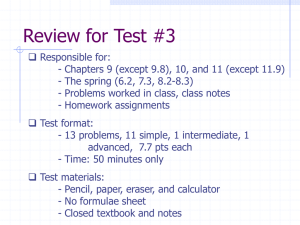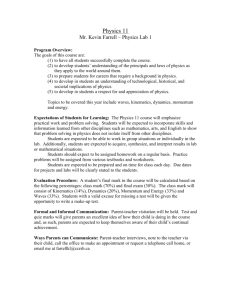physics ap physics syllabus
advertisement
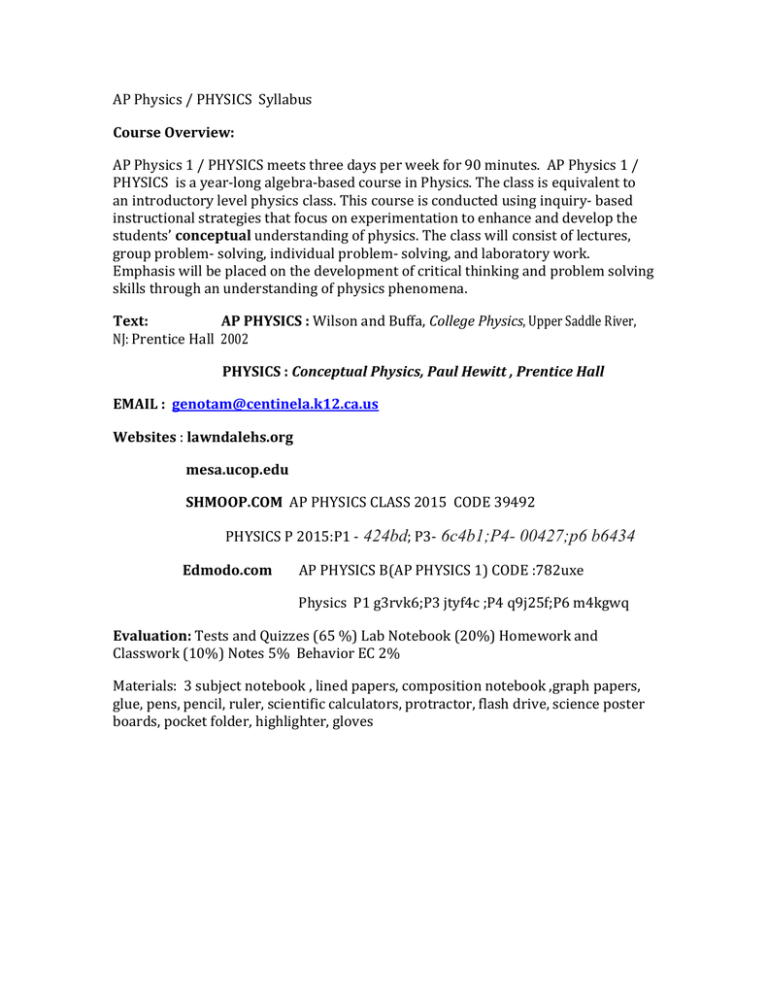
AP Physics / PHYSICS Syllabus Course Overview: AP Physics 1 / PHYSICS meets three days per week for 90 minutes. AP Physics 1 / PHYSICS is a year-long algebra-based course in Physics. The class is equivalent to an introductory level physics class. This course is conducted using inquiry- based instructional strategies that focus on experimentation to enhance and develop the students’ conceptual understanding of physics. The class will consist of lectures, group problem- solving, individual problem- solving, and laboratory work. Emphasis will be placed on the development of critical thinking and problem solving skills through an understanding of physics phenomena. Text: AP PHYSICS : Wilson and Buffa, College Physics, Upper Saddle River, NJ: Prentice Hall 2002 PHYSICS : Conceptual Physics, Paul Hewitt , Prentice Hall EMAIL : genotam@centinela.k12.ca.us Websites : lawndalehs.org mesa.ucop.edu SHMOOP.COM AP PHYSICS CLASS 2015 CODE 39492 PHYSICS P 2015:P1 - 424bd; P3- 6c4b1;P4- 00427;p6 b6434 Edmodo.com AP PHYSICS B(AP PHYSICS 1) CODE :782uxe Physics P1 g3rvk6;P3 jtyf4c ;P4 q9j25f;P6 m4kgwq Evaluation: Tests and Quizzes (65 %) Lab Notebook (20%) Homework and Classwork (10%) Notes 5% Behavior EC 2% Materials: 3 subject notebook , lined papers, composition notebook ,graph papers, glue, pens, pencil, ruler, scientific calculators, protractor, flash drive, science poster boards, pocket folder, highlighter, gloves Course Outline: Semester 1 Unit 1. Kinematics (CR2a) Kinematics in one dimension Vectors: vector components and resultant Kinematics in two dimension: projectile motion Unit 2. Dynamics (CR2b) Forces, types and representation – Free Body Diagrams Newton’s First Law Newton’s Third Law Newton’s 2nd Law and its Application Friction Interacting objects : Ropes and Pulleys Unit 3. Circular Motion and Gravitation (CR2c) Uniform Circular Motion Dynamics of Uniform Circular Motion Universal Law of Gravitation Unit 4. Energy (CR2f) Work Power Kinetic Energy Potential Energy: Gravitational and Elastic Conservation of Energy Unit 5: Momentum (CR2e) Impulse Momentum Conservation of Momentum Elastic and Inelastic Momentum Semester 2: Unit 6: Simple Harmonic Motion (CR2d) Linear restoring forces and simple harmonic motion Simple harmonic motion graphs Simple pendulum Mass-spring systems Unit 7: Rotational Motion(CR2g) Torque Center of mass Rotational Kinematics Rotational Dynamics and rotational inertia Rotational Energy Angular momentum Unit 8: Mechanical (CR2j) Traveling Waves Wave Characteristics Sound Superposition Standing waves on a String Standing sound waves Unit 9: Electrostatic (CR2h) Electric charge and conservation of charge Electric force: Coulomb’s Law Unit 10: DC Circuits (CR2i) Electric resistance Ohm’s Law DC Circuits Series and Parallel connections Kirchoff’s Laws Instructional Methods and Student Learning (Pedagogies): New topics are introduced to students initially in lecture format, but students are encouraged to ask questions and solve problems with the assistance of the instructor as well as with the assistance of other students in the class during the lecture portion of the course. Lectures are broken up by student problem solving, during which time students are encouraged to work with their peers and exchange ideas. The instructor is available to answer questions, but students are encouraged to use their own knowledge to communicate their questions to their peers and to the instructor. Hands-on investigations (described in the Laboratory section below) allow students to become actively engaged in the learning process. The instructor acts as a guide to help students in their collaborative development of their physics knowledge. Laboratory: Labs are placed throughout the course of the year. All lab experiments are hands-on and encourage students to work together in their lab groups. The course utilizes guided inquiry in most of the labs that require students to come up with a way to solve a problem themselves, using provided materials. Students are required to document all of their work in a lab notebook. The lab notebook includes a written report for each lab experiment. Unit 1: Kinematics 1. Project Match the graph – Relationship of position, speed, velocity and acceleration versus time 2. Egg Drop Free Fall Investigation – Compare the acceleration of egg package designs dropped simultaneously 3. Vector Addition – Determine the value of the resultant vector using graphical and analytical methods 4. Rocket and Glider Projectile Motion - Relationship between angle and range Unit 2: Dynamics 5.Coefficient of Friction – Determining coefficient of friction on an inclined plane 6. Newton’s Second Law- Determining the variation of acceleration of dynamic cart in two scenario: (1)total mass of the system is kept constant while net force varies, (2) net force kept constant and total mass of the system varies. 7. Mousetrap Car – Design and build a car solely powered by a regular mousetrap and travel an 30o incline. 8. Bridges – Design a bridge with specific specifications that will carry maximum load Unit 3: Circular Motion and Gravitation 9. Flying Toy – Determine the tension in the string and the centripetal acceleration of the flying toy . 10. Galileo’s Ramp – students use ramps at different angles to determine what happens to the acceleration . Unit 4: Energy 11. Roller Coaster Investigation – Design a simple roller coaster using provided materials to verify if the total energy is conserved if no external force is applied. 12.Work on an Inclined Plane – Calculate work done to move a mass Unit 5: Momentum 13. Air Track - Conservation of Momentum 14. Torque – Determine an unknown mass using translational and rotational equilibrium 15. Elastic and Inelastic Collisions – To investigate conservation of energy using a pendulum to determine type of collision Unit 6: Simple Harmonic Motion 16. Springs: Use Hooke’s law to analyze the spring constants of different springs 17.Pendulums - Determine the influence of mass, length, angle, and gravity on the period of a pendulum Unit 7: Rotational Motion 18. Prosthetic Arm – To design and build an apparatus that replicates the forearm and biceps muscle system and be able to do tasks such as throwing and relocating objects and determine the tension when holding different masses. 19. Conservation of Angular Momentum – To investigate how the angular momentum of a rotating system, respond to changes in in rotational inertia. Unit 8: Mechanical Waves 20. Mechanical Waves – To model the two types of mechanical waves with a spring toy to test whether or not these characteristics affect the speed of a pulse. 21. Speed of Sound: Determine the speed of sound with a tuning fork and a column of water Unit 9: Electrostatics 22. Static Electricity Interactions – students use sticky tape and a variety of objects to make qualitative observations of the interactions when objects are charged, discharged and re charged. Unit 10: DC Circuits 23. Voltage and Current- To determine the relationship between the current through a resistor and a voltage across the resistor 24.Series and Parallel Circuits – Construct electric circuits to verify Ohm’s Law Unit 11: Electric and Magnetic Field 25. Magnetic Field and Electric Field – To draw the lines of the magnetic field lines 26. Solenoid – To enhance the electromagnetic field 27. Electric Motors – To construct and test an electric motor CODE OF CONDUCT : Classroom Rules: /Consequences: 1. Respect everyone inside and outside the classroom in words and action at all times. (Phone Call/ Parent Conference / Dean) 2. 100% attention is expected during directed teaching.( Warning + Talk with Mrs. Genota /Detention) 3. Ask permission at all times.( Warning/Detention) 4. Full cooperation is a must in doing group activities.(Warning/Lose credit, Detention) 5. Be punctual in everything. (Warning /Detention/Lose Credit) 6. Cleanliness, neatness and orderliness should be observed in accomplishing all work. (Warning, repetition of work, Detention) 7. Safety rules should be strictly followed.(Detention, Lose Credit, Saturday School) 8. Ask questions and respond politely.( Warning, Detention , Saturday School) 9. Complete and submit all assignments and projects on time.( Lose Credit/ Detention ) 10. Bring the necessary materials daily. All backpacks must be placed under the desk. (Warning, Lose Credit ) 11. Honesty is a must at all times. (No cheating - Lose credit, Detention) 12. Obedience to school policies is mandatory (warning, detention, Saturday school, confiscation 13. Copy of Agenda, HW and Reflection (teaching practices and lessons learned) in your composition notebook, are required as passport for dismissal. 14. Respect, obedience to rules and completed work are mandatory in order to earn credit from the Substitute Teacher. (Lose credit , Detention, Saturday School). 15. Use Computer, IPAD, Graphing calculators and other technology responsibly. All use should only be school related. Consequences: 1) Warning and Seat / Group change 2) Talk with Mrs. Genota 3) Behavior Reflection/Phone Call Home/Blackboard 4) Lose EXTRA Credit Behavior Points- 2% 5) Lowers Citizenship Grade consistently after warnings Materials : Black/ blue pens Red pens for correcting # 2Pencils for tests 3 Subject Notebook –FLT, Agendas Cornell Notes , HW list and reflection Lined Papers Scientific Calculator Graphing paper GLUESTICK Flash Drive Composition Notebook for Lab oratory work Composition Notebook for Projects Display Board for Projects Hand Gloves for experiment FOR DONATIONS: extra Credit Hand sanitizer Paper towel Liquid Soap Hand Gloves SCIENCE PROJECT FORMAT Title Page Table of Contents Abstract Purpose Scope Background Information Physical Phenomena Experimental Procedures Materials & Procedures Data Table ( at least 3) Graphs Analysis and Conclusion Difficulties and Problems Recommendation Acknowledgements Appendix Glossary Ca Standards Drawings/ Diagrams with label and Measurements Pictures Formulas and Mathematical Calculations TEACHING PRACTICES Read with partners Cooperative Learning Discussion and Oral Presentation Technology Cornell Notes Organization Use of Immediate Feedback Techniques (White Board, True or False, ABCDE letter choices) Reflection Scientific Method- Problem Solving Hands On Activities- Experiments Team Projects Competitions Student Consultation – Before and After School and Lunch Time if necessary Immediate Grade Feedback GRADING SYSTEM NOTEBOOK – 5% HW/CW – 10 % LABORATORY EXPERIMENT AND PROJECTS – 20% QUIZZES AND TESTS-/ BENCHMARKS -65% EXCELLENT BEHAVIOR –EC 2% Please return this page ! - 10 pts-HW ; 2 pts –Behavior EC VIDEO/PHOTO RELEASE FORM DATE : ____________________________ THIS IS TO CERTIFY THAT I AM ALLOWING MY DAUGHTER / SON , ______________________________________________ TO BE FILMED OR PHOTOGRAPHED FOR NAME OF THE STUDENT/ GRADE ACADEMIC PURPOSE INSIDE THE CLASSROOM, DURING OUTDOOR ACTIVITIES, FIELD TRIPS , CONFERENCES AND COMPETITIONS RELATED TO THIS PHYSICS , AP PHYSICS AND MESA / STEM CLASSES. THANK YOU. ________________________________________________ PRINTED NAME OF PARENT / GUARDIAN ________________________________________________ SIGNATURE OF PARENT / GUARDIAN ________________________________________________ CONTACT NUMBER CONTRACT I agree with the policies, requirements and rules set in PHYSICS AND AP PHYSICS CLASS in Room A304 . I will fully comply with its citizenship and academic standards. _____________________________ _____________________________ Student’s Signature Parents/Guardian’s Signature _____________________________ ______________________________ Student’s Printed Name Parent’s or Guardian’s Printed Name Parent’s Contact Number Home :______________________________ Cell: ________________________________ Work: _______________________________ MRS. MARIA LYN GENOTA, MSEE PHYSICS , LAWNDALE HIGH SCHOOL
